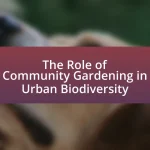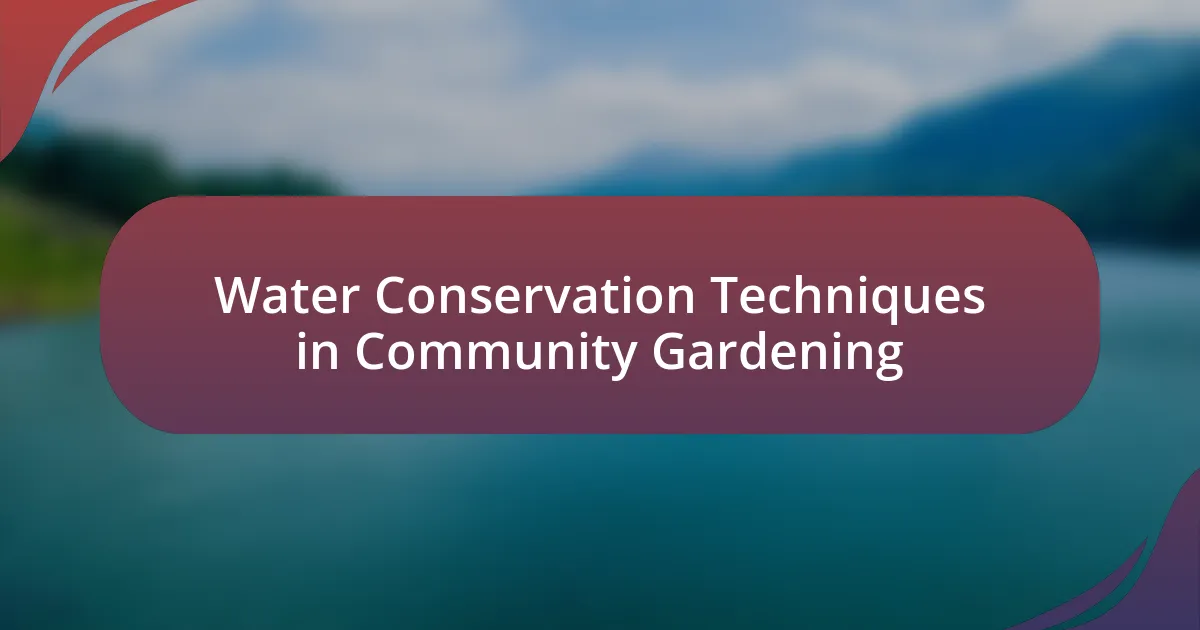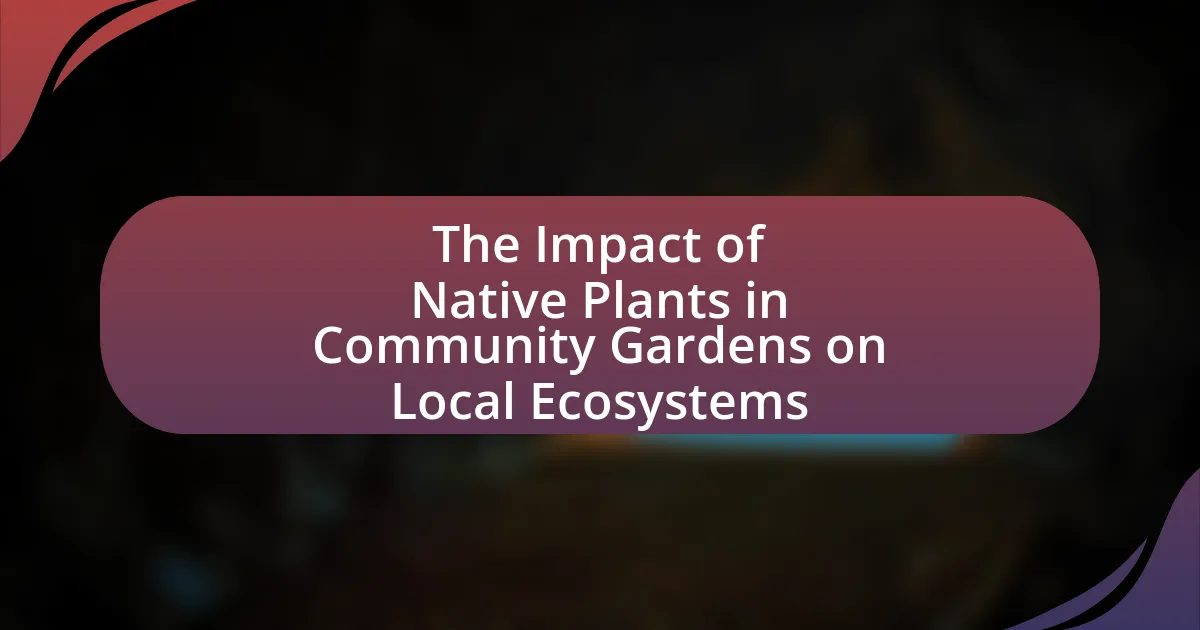Community gardens are shared spaces where individuals cultivate plants, primarily for food production and community engagement, while also enhancing local ecosystems. This article explores the significant role of community gardens in promoting pollinator habitats, emphasizing their contribution to biodiversity, food security, and environmental sustainability. Key topics include the types of plants grown in these gardens, the importance of pollinator habitats, and the challenges faced in maintaining diverse plant species. Additionally, it discusses best practices for creating effective pollinator habitats and the impact of community involvement on garden sustainability.
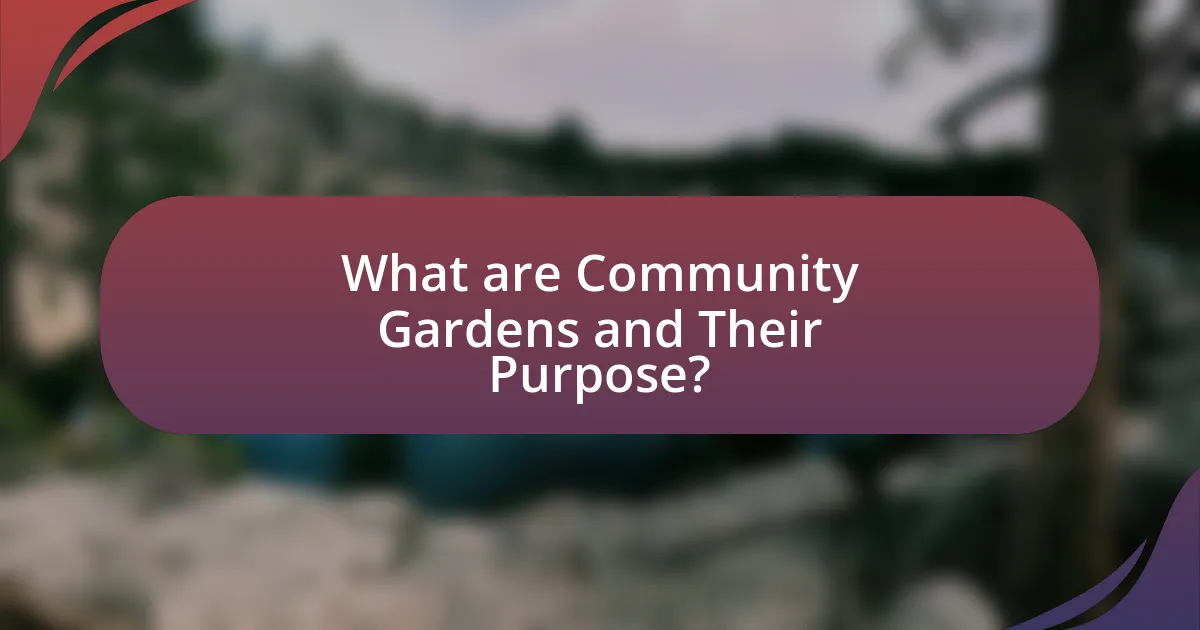
What are Community Gardens and Their Purpose?
Community gardens are shared plots of land where individuals or groups cultivate plants, primarily for food production and community engagement. Their purpose includes fostering community interaction, enhancing local food security, and promoting environmental sustainability. Research indicates that community gardens can increase biodiversity, providing essential habitats for pollinators, which are crucial for ecosystem health and agricultural productivity. For instance, a study published in the journal “Urban Ecosystems” found that community gardens significantly contribute to urban biodiversity by supporting various pollinator species, thereby reinforcing their role in promoting pollinator habitats.
How do community gardens contribute to local ecosystems?
Community gardens contribute to local ecosystems by enhancing biodiversity and providing habitats for pollinators. These gardens create diverse plant communities that attract various species of bees, butterflies, and other beneficial insects, which are essential for pollination. Research indicates that urban areas with community gardens have higher populations of pollinators compared to areas without such green spaces, demonstrating their role in supporting local ecosystems. Additionally, community gardens improve soil health and water retention, further benefiting the surrounding environment and promoting ecological balance.
What types of plants are typically grown in community gardens?
Community gardens typically grow a variety of plants, including vegetables, herbs, flowers, and fruits. Common vegetables include tomatoes, peppers, and lettuce, while herbs often consist of basil, cilantro, and parsley. Flowers such as sunflowers and marigolds are also popular, as they attract pollinators. The diversity of these plants supports local ecosystems and enhances pollinator habitats, which is essential for maintaining biodiversity. Studies have shown that community gardens with a mix of flowering plants can significantly increase pollinator populations, thereby contributing to ecological health.
How do community gardens promote biodiversity?
Community gardens promote biodiversity by providing diverse habitats that support various plant and animal species. These gardens often include a wide range of native plants, which attract pollinators such as bees, butterflies, and birds, thereby enhancing local ecosystems. Research indicates that urban areas with community gardens have higher species richness compared to those without, as these gardens serve as critical refuges for wildlife in densely populated regions. Additionally, the varied plant life in community gardens fosters interactions among species, contributing to ecological resilience and stability.
Why are pollinator habitats important?
Pollinator habitats are important because they support the survival and health of pollinators, which are essential for the reproduction of many plants and the production of food crops. These habitats provide the necessary resources such as food, shelter, and breeding sites for pollinators like bees, butterflies, and birds. Research indicates that approximately 75% of the world’s flowering plants and about 35% of global food crops depend on animal pollination, highlighting the critical role that pollinator habitats play in maintaining biodiversity and food security.
What role do pollinators play in food production?
Pollinators are essential for food production as they facilitate the reproduction of many flowering plants, including a significant portion of crops. Approximately 75% of the world’s food crops depend on animal pollination, which includes fruits, vegetables, and nuts. This reliance on pollinators contributes to biodiversity and enhances food security, as diverse crops can lead to more resilient agricultural systems. Studies have shown that the presence of pollinators can increase crop yields by up to 50%, underscoring their critical role in sustainable food production.
How does the decline of pollinator populations affect ecosystems?
The decline of pollinator populations negatively impacts ecosystems by disrupting plant reproduction and reducing biodiversity. Pollinators, such as bees and butterflies, are essential for the fertilization of approximately 75% of flowering plants, which include many crops and wild species. This decline leads to decreased fruit and seed production, ultimately threatening food sources for various organisms and diminishing habitat complexity. Studies indicate that ecosystems with fewer pollinators experience a decline in plant diversity, which can destabilize food webs and reduce resilience to environmental changes.

How do Community Gardens Promote Pollinator Habitats?
Community gardens promote pollinator habitats by providing diverse plant species that attract and support various pollinators, such as bees and butterflies. These gardens often include native flowering plants, which are essential for pollinator health, as they offer food sources and nesting sites. Research indicates that community gardens can increase local biodiversity; for instance, a study published in the journal “Urban Ecosystems” found that urban gardens significantly enhance the abundance and diversity of pollinator species compared to conventional landscapes. By fostering a variety of plants and creating a welcoming environment, community gardens play a crucial role in sustaining and enhancing pollinator populations.
What specific practices in community gardens support pollinator health?
Specific practices in community gardens that support pollinator health include planting diverse native flowering plants, providing nesting sites, and minimizing pesticide use. Diverse native plants attract a variety of pollinators, as they offer essential nectar and pollen sources throughout the growing season. Research indicates that gardens with a higher diversity of flowering plants can support more pollinator species, enhancing overall biodiversity. Additionally, incorporating features such as bee hotels or leaving areas of bare soil can provide critical nesting habitats for solitary bees. Reducing or eliminating pesticide use is crucial, as chemicals can harm pollinators; studies show that organic gardening practices lead to healthier pollinator populations.
How does planting native species benefit pollinators?
Planting native species benefits pollinators by providing them with essential food sources and habitat that are specifically adapted to their needs. Native plants produce nectar and pollen that are more nutritious and accessible for local pollinators, such as bees and butterflies, compared to non-native species. Research indicates that gardens with a higher diversity of native plants can support up to 50% more pollinator species, enhancing biodiversity and ecosystem resilience. Additionally, native plants are more likely to thrive in local soil and climate conditions, reducing the need for chemical fertilizers and pesticides that can harm pollinators.
What design elements in community gardens attract pollinators?
Design elements in community gardens that attract pollinators include diverse plant species, native plants, and habitat features such as water sources and nesting sites. Diverse plant species provide a variety of nectar and pollen sources, which are essential for different pollinator species. Native plants are particularly effective because they have co-evolved with local pollinators, offering the specific resources they need. Additionally, incorporating features like shallow water sources and undisturbed areas for nesting can create a welcoming environment for pollinators. Research indicates that gardens with these elements can significantly increase pollinator visitation rates, enhancing biodiversity and ecosystem health.
How can community gardens educate the public about pollinators?
Community gardens can educate the public about pollinators by providing hands-on experiences that demonstrate the importance of these species in food production and ecosystem health. Through workshops, guided tours, and interactive displays, community gardens can teach visitors about the various types of pollinators, such as bees and butterflies, and their roles in pollination. Research indicates that educational programs in community gardens can increase awareness and knowledge about pollinator conservation, as evidenced by a study published in the Journal of Environmental Education, which found that participants in garden-based education programs showed a significant increase in understanding of pollinator ecology and conservation strategies.
What programs can be implemented to raise awareness?
Programs that can be implemented to raise awareness about the role of community gardens in promoting pollinator habitats include educational workshops, community outreach initiatives, and social media campaigns. Educational workshops can provide hands-on experiences and information about pollinator-friendly plants and gardening practices, fostering community engagement. Community outreach initiatives, such as local events or partnerships with schools, can disseminate information about the importance of pollinators and how community gardens can support them. Social media campaigns can leverage platforms to share success stories, tips, and resources, reaching a broader audience and encouraging participation in community gardening efforts. These programs are effective as they directly engage the community and provide actionable knowledge, which is essential for fostering awareness and support for pollinator habitats.
How can community involvement enhance educational efforts?
Community involvement enhances educational efforts by providing practical, hands-on experiences that reinforce learning. For instance, when community members participate in community gardens, they engage in activities that teach them about biodiversity, ecology, and sustainable practices. Research shows that experiential learning in such environments increases retention of knowledge; a study by the University of California found that students involved in garden-based education scored higher on science assessments compared to those who did not participate. This direct engagement fosters a deeper understanding of environmental issues, such as the importance of pollinator habitats, thereby enriching the educational experience.
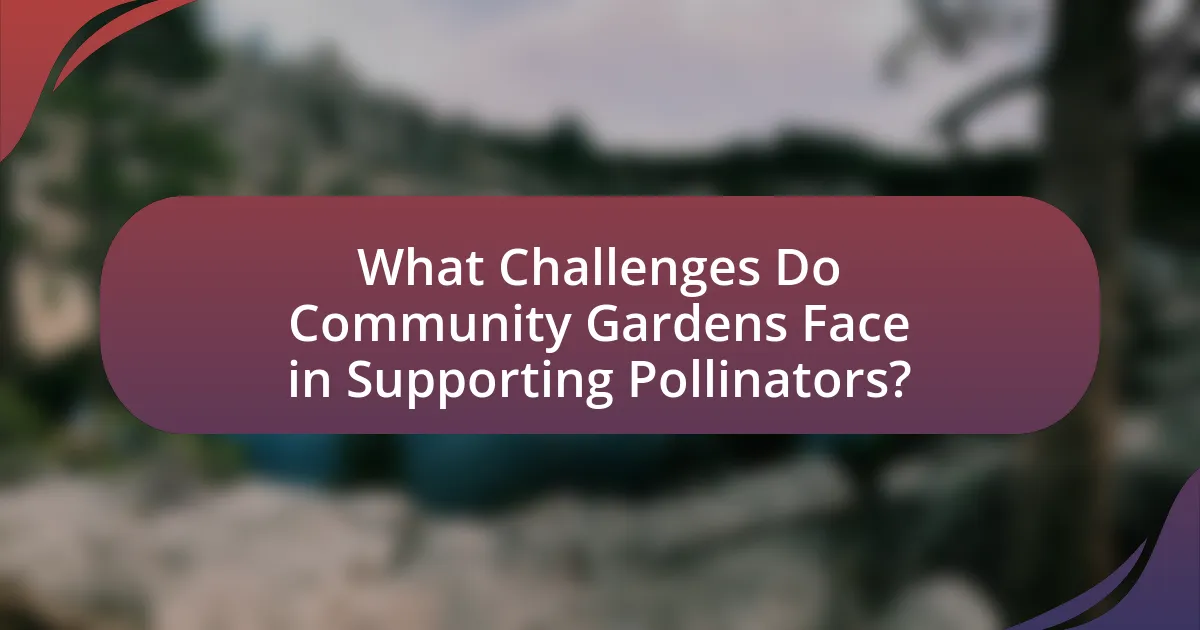
What Challenges Do Community Gardens Face in Supporting Pollinators?
Community gardens face several challenges in supporting pollinators, primarily due to limited biodiversity, pesticide use, and habitat fragmentation. Limited biodiversity occurs when gardens primarily cultivate a narrow range of plants, which restricts the availability of food sources for various pollinator species. Pesticide use poses a significant threat, as chemicals intended for pest control can harm beneficial insects, including bees and butterflies. Habitat fragmentation results from urban development, which can isolate community gardens and reduce their connectivity to larger green spaces, making it difficult for pollinators to thrive. These challenges hinder the effectiveness of community gardens in promoting healthy pollinator populations.
What environmental factors impact the effectiveness of community gardens?
Environmental factors that impact the effectiveness of community gardens include soil quality, sunlight exposure, water availability, and local biodiversity. Soil quality affects plant growth and nutrient availability, with studies indicating that healthy, nutrient-rich soil leads to more productive gardens. Sunlight exposure is crucial, as most vegetables and flowers require at least six hours of direct sunlight daily to thrive. Water availability is essential for sustaining plant health; gardens in areas with adequate irrigation systems or natural rainfall perform better. Additionally, local biodiversity, including the presence of pollinators like bees and butterflies, enhances the productivity of community gardens by improving pollination rates, which is vital for fruit and seed production. Research has shown that gardens located in biodiverse areas yield higher crop outputs, demonstrating the interconnectedness of these environmental factors.
How do urbanization and land use changes affect pollinator habitats?
Urbanization and land use changes significantly degrade pollinator habitats by reducing the availability of natural landscapes and floral resources. As urban areas expand, green spaces are often replaced with impervious surfaces, leading to habitat fragmentation and loss of biodiversity. Studies indicate that urban environments typically support fewer pollinator species due to limited food sources and nesting sites, with research showing that cities can reduce pollinator abundance by up to 50% compared to rural areas. Furthermore, land use changes, such as agricultural intensification, often involve the use of pesticides that can harm pollinator populations, further exacerbating the decline in their habitats.
What are the challenges of maintaining diverse plant species?
Maintaining diverse plant species faces several challenges, including habitat loss, invasive species, and climate change. Habitat loss, driven by urbanization and agricultural expansion, reduces the available space for diverse plant communities to thrive. Invasive species can outcompete native plants, leading to a decline in biodiversity. Climate change alters growing conditions, affecting plant survival and distribution. According to the Intergovernmental Panel on Climate Change, these factors collectively threaten the resilience of ecosystems that support diverse plant species.
How can community gardens overcome these challenges?
Community gardens can overcome challenges by implementing collaborative management strategies and fostering community engagement. These gardens often face issues such as resource limitations and lack of participation, which can be addressed through organized volunteer programs and partnerships with local organizations. For instance, studies show that community involvement increases garden sustainability and productivity, as seen in the 2016 research by the American Community Gardening Association, which highlighted that gardens with active community participation had a 30% higher yield. Additionally, providing educational workshops on pollinator-friendly practices can enhance knowledge and commitment among participants, leading to improved habitat conditions for pollinators.
What strategies can be employed to enhance pollinator habitats?
To enhance pollinator habitats, strategies include planting diverse native flowering plants, creating nesting sites, and reducing pesticide use. Planting a variety of native species ensures a continuous food source for pollinators throughout the growing season, as native plants are adapted to local ecosystems and provide the necessary nutrients. Establishing nesting sites, such as leaving bare soil for ground-nesting bees or installing bee hotels for solitary bees, supports their reproduction. Additionally, minimizing pesticide application protects pollinators from harmful chemicals; studies show that neonicotinoids, a common pesticide class, can significantly harm bee populations. Implementing these strategies can lead to healthier and more sustainable pollinator habitats.
How can community collaboration improve garden sustainability?
Community collaboration can significantly improve garden sustainability by pooling resources, knowledge, and labor among participants. When individuals work together, they can share best practices for organic gardening, pest management, and soil health, leading to more effective and sustainable gardening methods. Research indicates that community gardens with active collaboration often yield higher biodiversity, which is crucial for pollinator habitats, as diverse plant species attract a wider range of pollinators. Additionally, collaborative efforts can lead to shared composting initiatives, reducing waste and enhancing soil fertility, thus promoting long-term sustainability in community gardens.
What are some best practices for creating effective pollinator habitats in community gardens?
To create effective pollinator habitats in community gardens, incorporate a diverse range of native flowering plants that bloom at different times throughout the growing season. This diversity ensures a continuous food source for pollinators, which is crucial for their survival and health. Research indicates that native plants are more beneficial to local pollinator species compared to non-native varieties, as they provide the specific nectar and pollen that these species have evolved to utilize. Additionally, maintaining undisturbed areas, such as patches of bare soil or leaf litter, supports ground-nesting bees and other beneficial insects. Implementing organic gardening practices, such as avoiding pesticides and using natural pest control methods, further enhances the habitat’s safety for pollinators. These practices collectively contribute to a thriving ecosystem within community gardens, promoting biodiversity and ecological balance.
How can gardeners select the right plants for pollinators?
Gardeners can select the right plants for pollinators by choosing native species that provide nectar and pollen throughout the growing season. Native plants, such as coneflowers and milkweeds, are specifically adapted to local pollinators, ensuring a reliable food source. Research indicates that gardens with a diverse array of native plants attract more pollinators, as these species have co-evolved with local insects, making them more effective in supporting pollinator populations. Additionally, incorporating plants with varying bloom times ensures that pollinators have access to food from early spring to late fall, enhancing habitat sustainability.
What maintenance practices support long-term pollinator health?
Regular maintenance practices that support long-term pollinator health include planting diverse native flora, minimizing pesticide use, and ensuring habitat continuity. Diverse native plants provide essential food sources and nesting sites for various pollinator species, enhancing their survival and reproduction rates. Research indicates that gardens with a variety of flowering plants can support up to 50% more pollinator species compared to monoculture landscapes. Additionally, reducing or eliminating pesticide application protects pollinators from harmful chemicals, which can lead to population declines. Maintaining habitat continuity through practices such as leaving areas of bare ground for nesting and providing shelter from wind and rain further supports pollinator health by creating stable environments for them to thrive.


